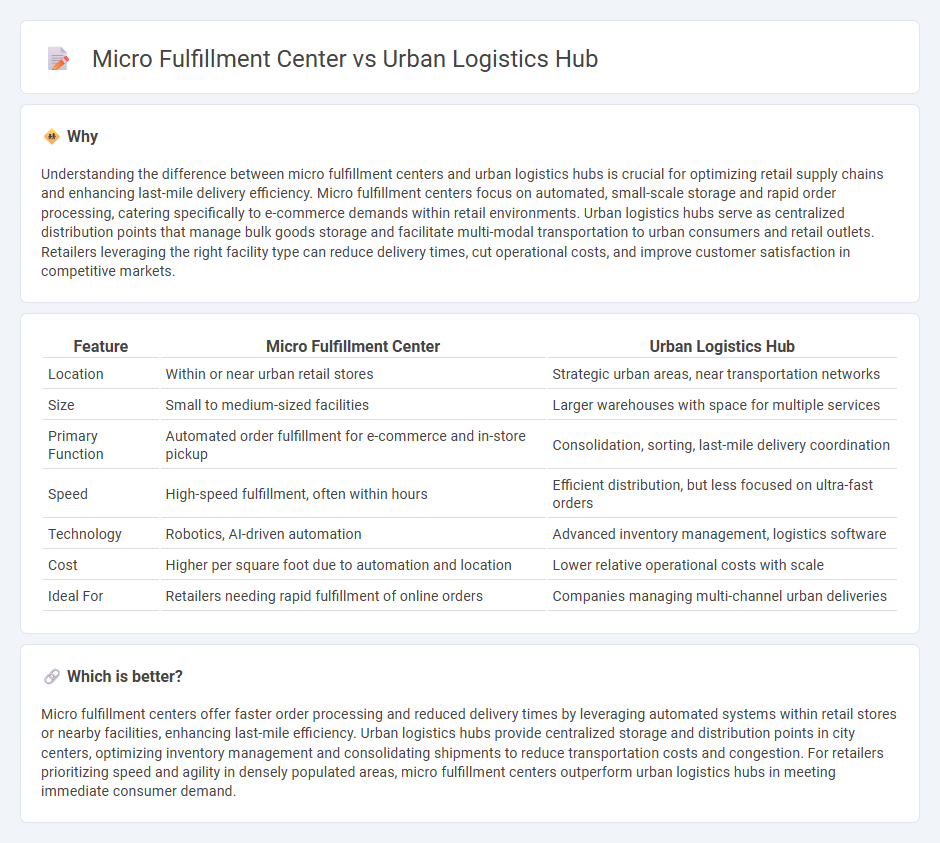
Micro fulfillment centers optimize retail operations by enabling rapid order processing and reducing delivery times within urban areas. Urban logistics hubs serve as centralized points for inventory storage and distribution, enhancing supply chain efficiency and supporting last-mile delivery in densely populated regions. Explore the differences in scalability, technology integration, and operational focus to determine the best solution for modern retail logistics.
Why it is important
Understanding the difference between micro fulfillment centers and urban logistics hubs is crucial for optimizing retail supply chains and enhancing last-mile delivery efficiency. Micro fulfillment centers focus on automated, small-scale storage and rapid order processing, catering specifically to e-commerce demands within retail environments. Urban logistics hubs serve as centralized distribution points that manage bulk goods storage and facilitate multi-modal transportation to urban consumers and retail outlets. Retailers leveraging the right facility type can reduce delivery times, cut operational costs, and improve customer satisfaction in competitive markets.
Comparison Table
| Feature | Micro Fulfillment Center | Urban Logistics Hub |
|---|---|---|
| Location | Within or near urban retail stores | Strategic urban areas, near transportation networks |
| Size | Small to medium-sized facilities | Larger warehouses with space for multiple services |
| Primary Function | Automated order fulfillment for e-commerce and in-store pickup | Consolidation, sorting, last-mile delivery coordination |
| Speed | High-speed fulfillment, often within hours | Efficient distribution, but less focused on ultra-fast orders |
| Technology | Robotics, AI-driven automation | Advanced inventory management, logistics software |
| Cost | Higher per square foot due to automation and location | Lower relative operational costs with scale |
| Ideal For | Retailers needing rapid fulfillment of online orders | Companies managing multi-channel urban deliveries |
Which is better?
Micro fulfillment centers offer faster order processing and reduced delivery times by leveraging automated systems within retail stores or nearby facilities, enhancing last-mile efficiency. Urban logistics hubs provide centralized storage and distribution points in city centers, optimizing inventory management and consolidating shipments to reduce transportation costs and congestion. For retailers prioritizing speed and agility in densely populated areas, micro fulfillment centers outperform urban logistics hubs in meeting immediate consumer demand.
Connection
Micro fulfillment centers enhance urban logistics hubs by enabling faster order processing and last-mile delivery within densely populated areas. These centers leverage automation and data analytics to optimize inventory management, reducing transportation costs and delivery times in urban logistics networks. By integrating micro fulfillment centers, urban logistics hubs improve supply chain efficiency and support the growing demand for e-commerce in retail environments.
Key Terms
Last-mile delivery
Urban logistics hubs serve as centralized distribution points within city centers, streamlining inventory management and enabling efficient bulk shipments. Micro fulfillment centers operate closer to end consumers, utilizing automation to expedite last-mile delivery with reduced transit times. Explore the strategic advantages of each to optimize your urban delivery network.
Inventory proximity
Urban logistics hubs centralize inventory in strategic city locations to optimize distribution speed and reduce last-mile delivery costs. Micro fulfillment centers focus on inventory proximity by placing small-scale fulfillment units closer to end consumers, enabling rapid order processing and increased delivery efficiency. Explore how these models impact urban supply chains and customer satisfaction for deeper insights.
Order consolidation
Order consolidation in urban logistics hubs involves aggregating shipments from multiple suppliers to streamline last-mile delivery, reducing transportation costs and environmental impact. Micro fulfillment centers optimize order consolidation by processing small, local inventories close to consumers, enabling faster and more accurate order batching and pickup. Explore the differences in how these facilities enhance order consolidation efficiency and customer satisfaction.
Source and External Links
Urban logistics hubs: Six case studies - Urban logistics hubs are strategically located urban facilities that consolidate, manage, and distribute freight, particularly optimizing last-mile deliveries to reduce vehicle trips and environmental impacts.
Urban Logistics Hubs Summary and Conclusions - OECD - Urban logistics hubs (ULH) serve as critical nodes within cities to consolidate and manage freight including returns, improving logistics efficiency and sustainability by reducing costs and environmental impacts in last-mile delivery.
Urban Logistics Hubs - International Transport Forum (ITF) - Urban logistics hubs address complexities in city freight transport by consolidating deliveries to reduce pollution, congestion, and support sustainable transport modes like cargo bikes and electric vans.
 dowidth.com
dowidth.com